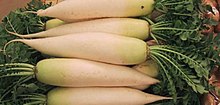| Daikon | |
|---|---|
 | |
| A pile of daikon radishes. | |
| Scientific classification | |
| Kingdom: | Plantae |
| (unranked): | Angiosperms |
| (unranked): | Eudicots |
| (unranked): | Rosids |
| Order: | Brassicales |
| Family: | Brassicaceae |
| Genus: | Raphanus |
| Species: | R. sativus |
| Variety: | R. sativus var. longipinnatus[1] |
| Trinomial name | |
| Raphanus sativus var. longipinnatus L.H.Bailey | |
Although there are many varieties of daikon, the most common in Japan, the aokubi-daikon, has the shape of a giant carrot, approximately 20 to 35 cm (7.9 to 14 in) long and 5 to 10 cm (2.0 to 3.9 in) in diameter. One of the most unusually shaped varieties of daikon cultivated in Kagoshima Prefecture is the turnip-shaped sakurajima daikon, which often grows as large as 50 cm (20 in) in diameter and weighs as much as 45 kg (99 lb).[5]
The flavour is generally rather mild compared to smaller radishes.
Contents
|
Culture

Sakurajima daikon
Use
In Chinese cuisine, turnip cake and chai tow kway are made with daikon.In Korean cuisine, kkakdugi and nabak kimchi use the vegetable, in addition to the soup moo-guk.
In Japanese cuisine, many types of pickles are made with daikon including takuan and bettarazuke. Daikon is also frequently used shredded and mixed into ponzu (a soy sauce and citrus juice condiment) as a dip. Simmered dishes are also popular such as oden. Cut and dried daikon is called 'Kiriboshi-daikon'(literally, cut-dried daikon) which is a common method of preserving food in Japan. Daikon radish sprouts ('Kaiware-daikon') are used for salad or garnishing of sashimi. Daikon leaf is frequently eaten as green vegetables. Pickles and stir frying are common. And Daikon leaf is one of a leaves of Festival of Seven Herbs, called 'suzushiro'.
In Pakistani cuisine, the leaves of the daikon plant are boiled and flash fried with a mixture of heated oil, garlic, ginger, red chili and a variety of spices. The radish is eaten as a fresh salad often seasoned with either salt and pepper or Chaat masala.

No comments:
Post a Comment